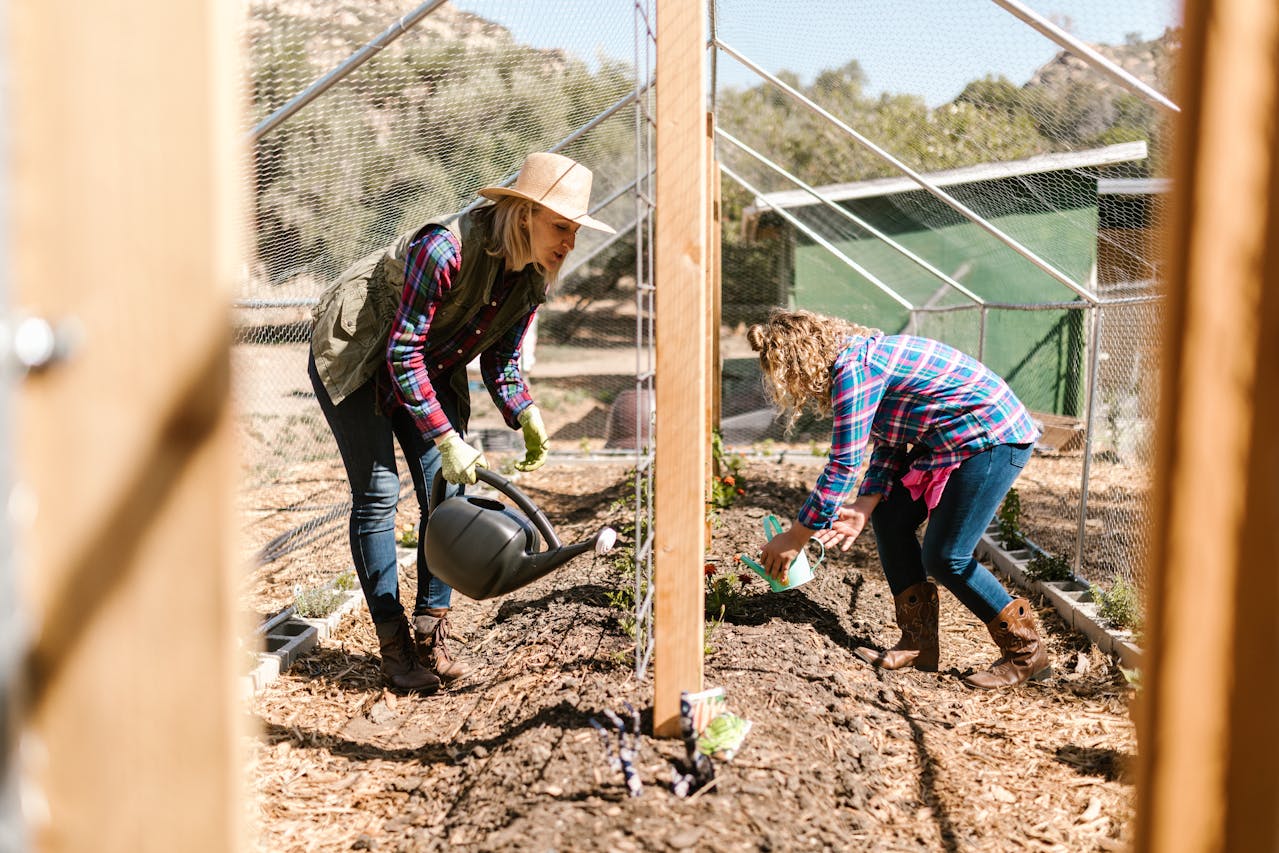How Community Gardens Can Promote Sustainable Water Use

Community gardens are shared spaces where people grow fruits, vegetables, and flowers together. These gardens bring people closer to nature, improve food access, and strengthen communities. However, like all gardens, they need water to thrive.
With water shortages becoming more common and costs rising, it’s important to use water wisely. If community gardens don’t manage their water well, they can waste a lot of it. That’s why sustainable water use is key. By making small changes, community gardens can use less water without harming their plants.
Water Challenges in Community Gardens
Community gardens face several water-related problems.
• Water shortages and high costs: In many areas, water isn’t always available or affordable. Gardens that rely on tap water can end up with high bills, making it hard to maintain them.
• Overwatering and waste: Sometimes, people water their plants too much or at the wrong time, leading to unnecessary water loss.
• Effects of climate change: Rising temperatures and unpredictable rainfall make it harder to plan for water needs. Some regions experience long dry spells, making water even more precious.
Since water is so important for gardening, community gardens must find ways to use it wisely.
Ways Community Gardens Can Save Water
1. Rainwater Harvesting
Instead of relying only on tap water, community gardens can collect rainwater. Large barrels or tanks can store rainwater from rooftops or special collection systems. This water can be used to irrigate plants, reducing dependence on municipal water supplies.
2. Drip Irrigation Systems
Drip irrigation is a simple but effective way to water plants. Instead of spraying water all over, drip irrigation delivers water directly to the roots. This reduces evaporation and ensures plants get the right amount of moisture without waste.
3. Mulching
Mulching involves covering the soil with natural materials like dry leaves, straw, or wood chips. This helps the soil retain moisture, preventing water from evaporating too quickly. It also keeps weeds down, reducing competition for water.
4. Using Drought-Resistant Plants
Not all plants need the same amount of water. Some, like succulents and native plants, require less water and can survive in dry conditions. Community gardens can choose such plants to reduce overall water use.
5. Watering at the Right Time
Timing matters when it comes to watering. Watering early in the morning or late in the evening reduces evaporation. Watering deeply but less often helps roots grow deeper, making plants more resilient during dry periods.
Educating the Community on Water Conservation
One of the biggest benefits of community gardens is the opportunity to educate people. Garden members can learn about water-saving techniques and apply them in their own homes.
• Workshops can teach people about rainwater harvesting, proper irrigation, and choosing the right plants.
• Local events can spread awareness about the importance of sustainable water use.
• Social media pages or newsletters can share tips, success stories, and updates on water conservation efforts.
When people understand the importance of saving water, they’re more likely to take action.
Community Gardens as a Model for Sustainable Living
Community gardens don’t just help people grow food – they also teach valuable lessons about the environment. When people see the benefits of water conservation in the garden, they’re more likely to practice the same habits at home.
Using Compost to Improve Soil Water Retention
Healthy soil holds water better. Compost improves soil structure, allowing it to retain moisture for longer. Adding organic matter like vegetable scraps and leaves reduces the need for frequent watering.
Building Water-Efficient Garden Layouts
A well-planned garden layout can save water. Placing plants with similar water needs together prevents overwatering. Raised beds and contour gardening help direct water to where it’s needed most.
Encouraging Shared Water Resources
Community gardens can store and share water efficiently. Setting up storage tanks and using a fair watering schedule ensures that all members have access to water without overusing it.
Reducing Water Pollution in Community Gardens
Pesticides and chemical fertilizers can contaminate water sources. Using natural compost and organic pest control prevents harmful chemicals from washing into rivers or underground water supplies.
Partnering with Local Authorities for Water Support
Community gardens don’t have to handle water conservation efforts alone. By working with local authorities, they can access resources, funding, and expert advice to improve their water management systems. Here are some ways these partnerships can be beneficial:
Seeking Municipal or Government Programs for Water Conservation
Many cities and local governments have programs aimed at promoting sustainable water use. These may include:
• Rainwater harvesting incentives – Some municipalities offer rebates or free rain barrels to encourage rainwater collection.
• Water-efficient irrigation grants – Funding is sometimes available for installing drip irrigation systems, water storage tanks, or other conservation tools.
• Educational workshops – Local water departments or agricultural extension offices may offer free training on water-saving techniques for gardeners.
By staying informed about these programs, community gardens can take advantage of available support.
Applying for Grants and Funding
There are various grants and funding opportunities from environmental organizations, government bodies, and non-profits that support water conservation projects. These funds can help gardens:
• Install better irrigation systems
• Build water storage facilities
• Purchase drought-resistant plants
• Organize community education programs
Writing a simple grant proposal explaining the garden’s water conservation efforts and its community benefits can increase the chances of receiving financial support.
Collaborating with Local Water Experts
Local universities, agricultural institutions, and water conservation organizations often have experts who can provide guidance on sustainable gardening practices. Some ways to collaborate include:
• Inviting specialists to teach workshops on water-efficient gardening
• Getting help designing a water-smart garden layout
• Partnering with local engineers or hydrologists to create rainwater collection and storage systems
By leveraging expert knowledge, community gardens can implement better strategies for long-term water sustainability.
Working with Local Businesses for Sponsorships and Donations
Local businesses, especially those involved in gardening, agriculture, or sustainability, may be willing to support community gardens. They can provide:
• Free or discounted garden supplies (e.g., hoses, mulch, compost bins)
• Financial sponsorships for water conservation projects
• Advertising and awareness campaigns to encourage water-wise gardening in the broader community
Building strong relationships with local authorities and businesses creates a support network that ensures the garden remains sustainable and water-efficient in the long run.
Encouraging Water Recycling in Community Gardens
Water used in the garden doesn’t have to come from fresh sources. Greywater – clean but used water from homes – can be repurposed for irrigation. Water from washing vegetables, rinsing rice, or even leftover drinking water can be collected and used on plants instead of pouring it down the drain.
Community gardens can also set up simple water filtration systems to clean and reuse water safely. Educating members on safe recycling methods ensures that water is used efficiently without harming the plants or soil.
Creating Shade and Wind Barriers to Reduce Water Loss
Excess heat and strong winds can dry out soil quickly, leading to more water use. Community gardens can plant trees, tall shrubs, or install shade nets to protect plants from direct sunlight and reduce evaporation.
Wind barriers, like hedges or fences, help slow down strong winds that can strip moisture from plants. By strategically placing these natural shields, gardens can create a cooler, more water-efficient environment for their crops.
Promoting Traditional and Indigenous Water-Saving Techniques
Many cultures have long practiced water-saving farming methods that still work today. Techniques like “olla irrigation,” where clay pots are buried in the soil and slowly release water to plant roots, can reduce water waste.
Other methods include “zai pits” (small planting pits that capture rainwater) and “swales” (shallow trenches that direct water to plants). Community gardens can learn from these traditional practices to improve their water efficiency without expensive technology.
Supporting Pollinators and Beneficial Insects
Pollinators like bees and butterflies help gardens thrive, while certain insects, like ladybugs and praying mantises, help control pests. Encouraging these natural helpers reduces the need for chemical pesticides, which can contaminate water sources.
Community gardens can plant flowers that attract pollinators, create insect-friendly habitats, and educate members about the importance of biodiversity. Healthier ecosystems lead to better water retention in soil, stronger plants, and a more sustainable garden overall.
Hosting Water Conservation Competitions and Incentives
To make water-saving fun and engaging, community gardens can organize competitions among members. For example:
• A challenge to see who can grow the most produce using the least amount of water
• Rewarding creative water-saving techniques
• A monthly recognition program for members who consistently follow sustainable watering practices
Friendly competitions encourage members to stay committed to water conservation while sharing ideas and learning from one another.
Conclusion
Community gardens are more than just places to grow food – they are powerful tools for promoting sustainable water use. By adopting simple yet effective methods like rainwater harvesting, drip irrigation, mulching, and planting drought-resistant crops, these gardens can significantly reduce water waste.
Beyond water-saving techniques, the role of education is crucial. Teaching members about composting, efficient garden layouts, and traditional water-saving practices spreads awareness and encourages responsible habits. Additionally, efforts like recycling greywater, creating shade, and supporting pollinators help strengthen the overall ecosystem.
Partnerships with local authorities and NGOs like Aqua Maya, or organizing competitions and knowledge-sharing, create a sense of community and shared responsibility. When people see the impact of these strategies in their community garden, they are more likely to apply them at home, leading to a larger movement toward sustainable living.
Every drop of water saved in a community garden contributes to a more resilient future. With climate change and water scarcity becoming bigger issues, now is the time for more communities to embrace water-wise gardening. The changes may seem small, but together, they make a big difference.






